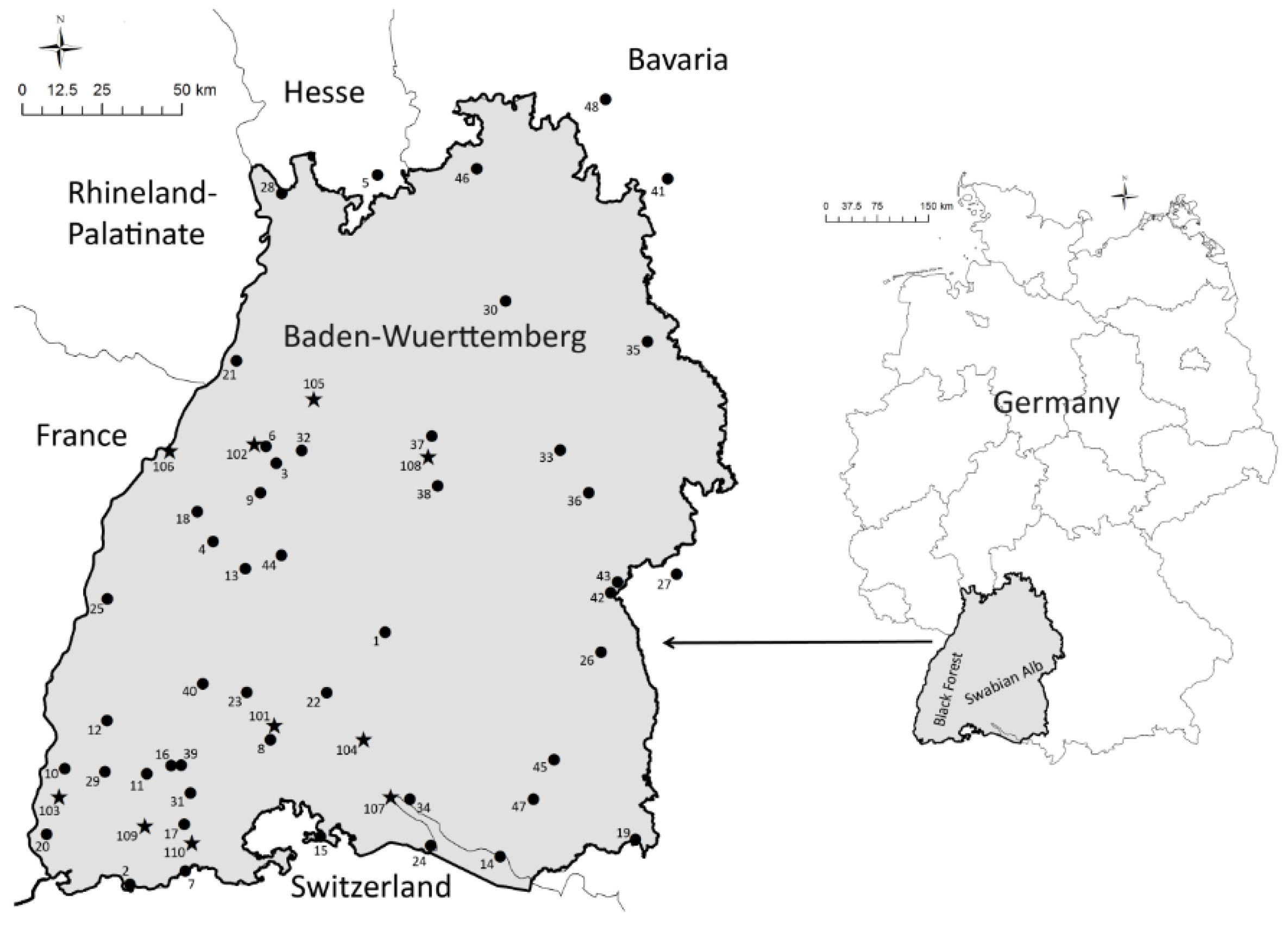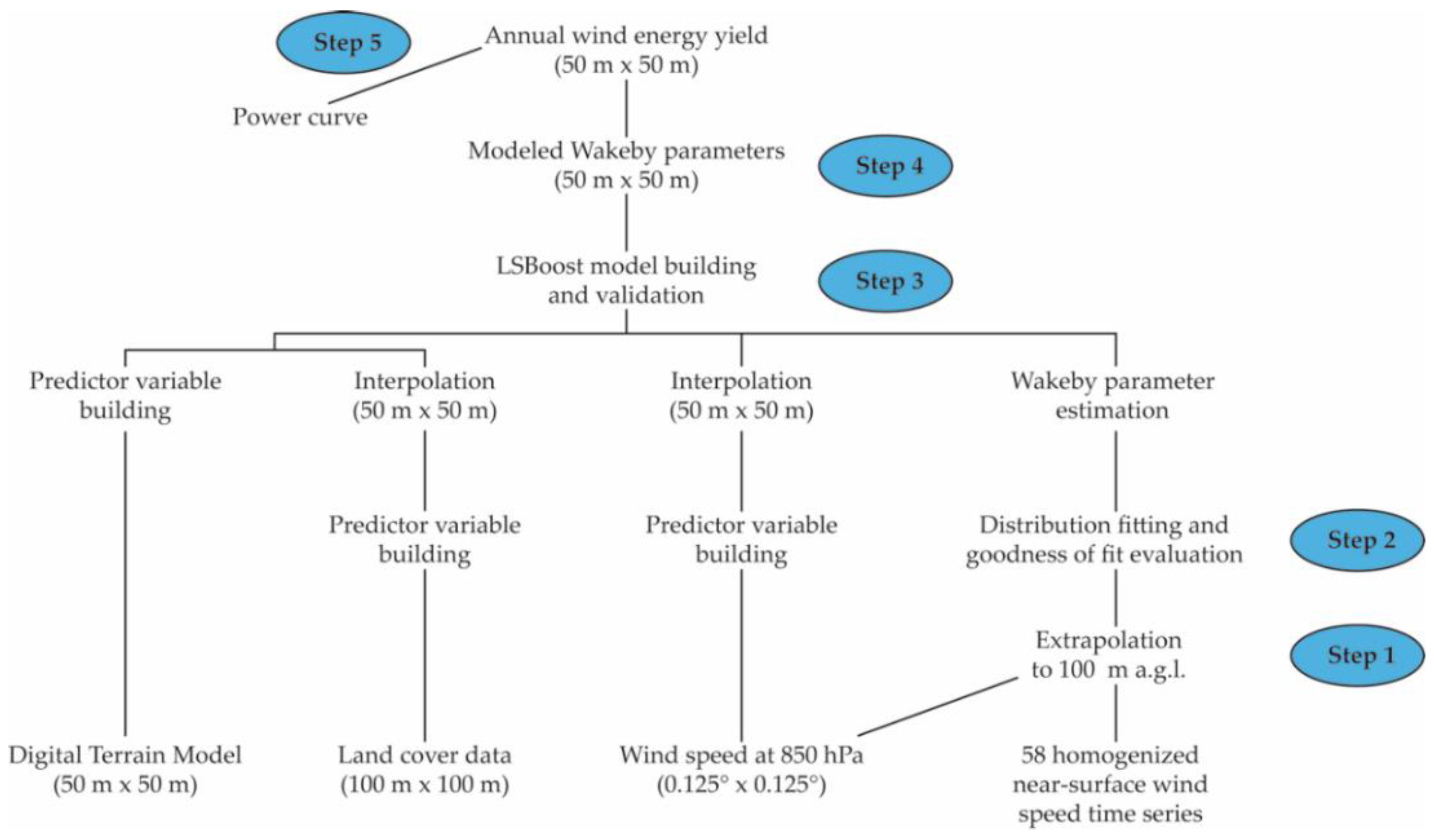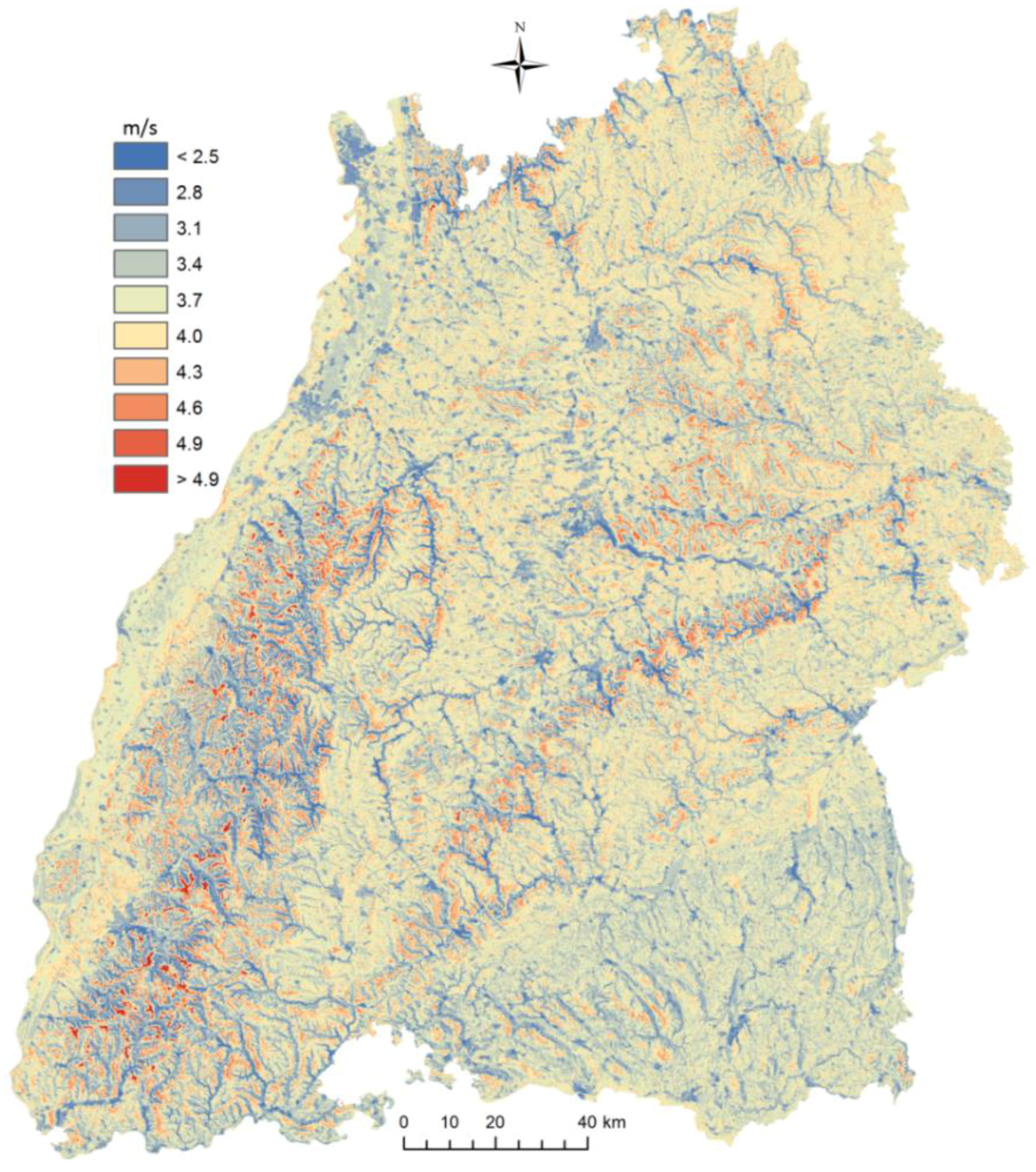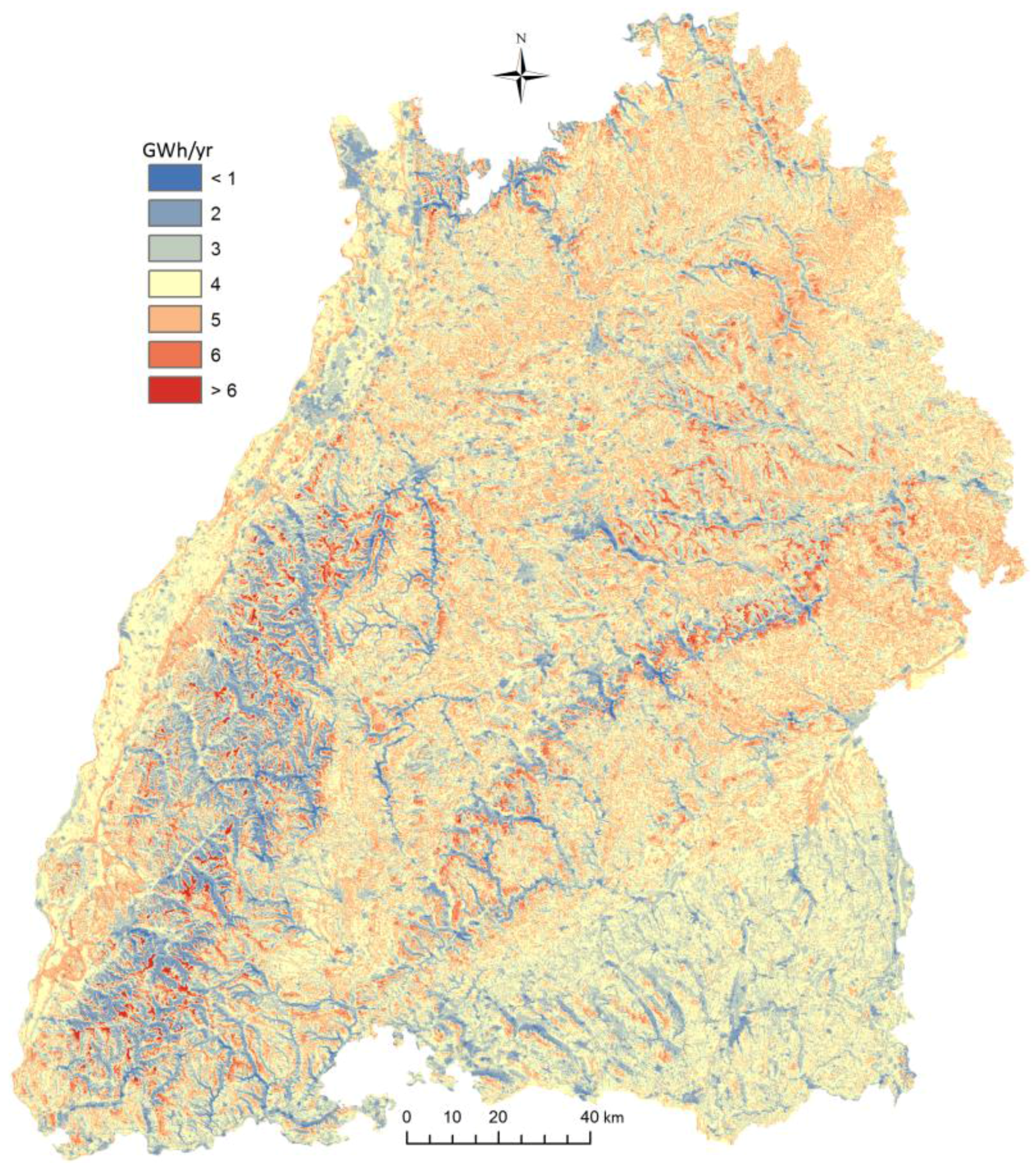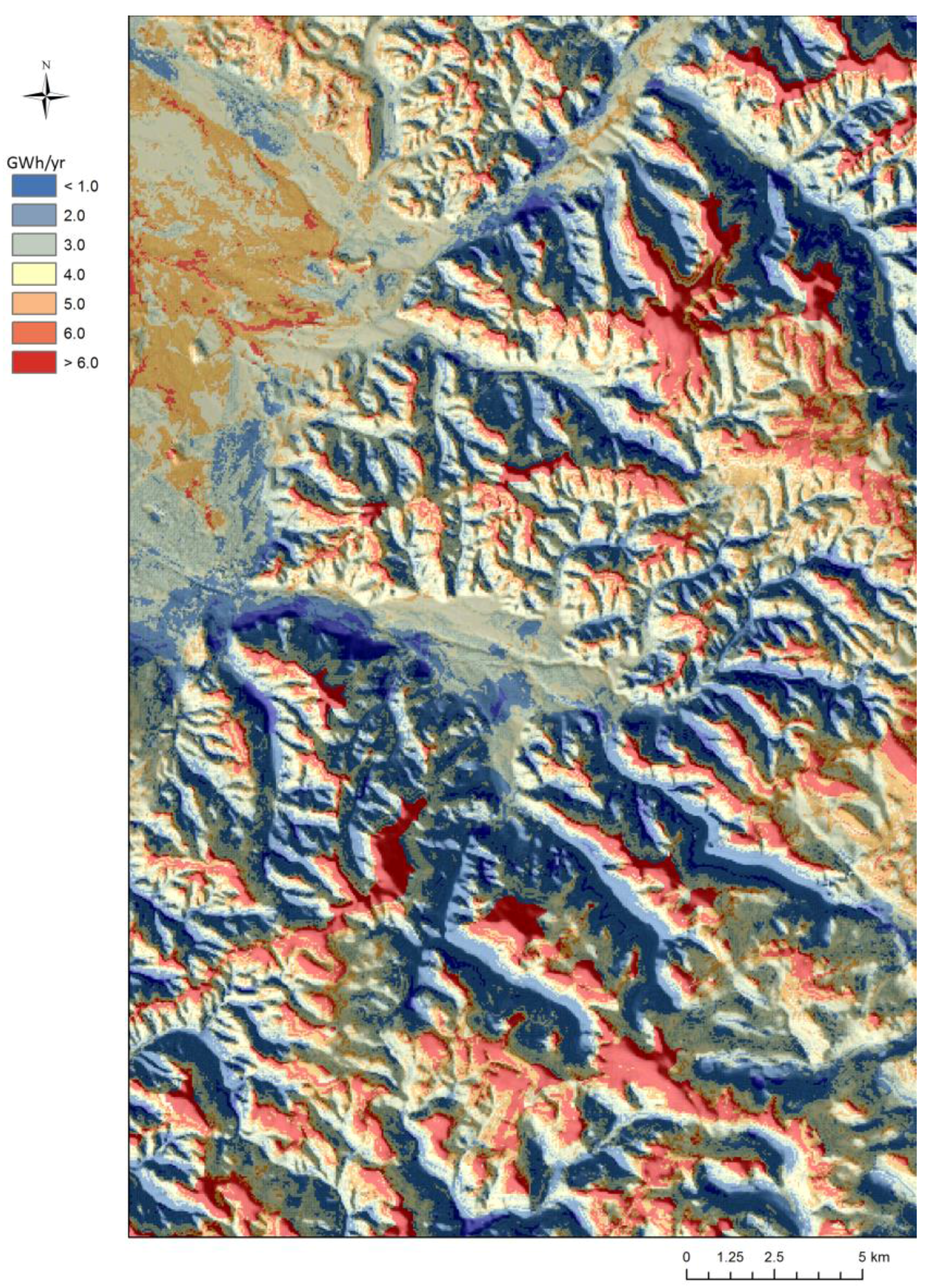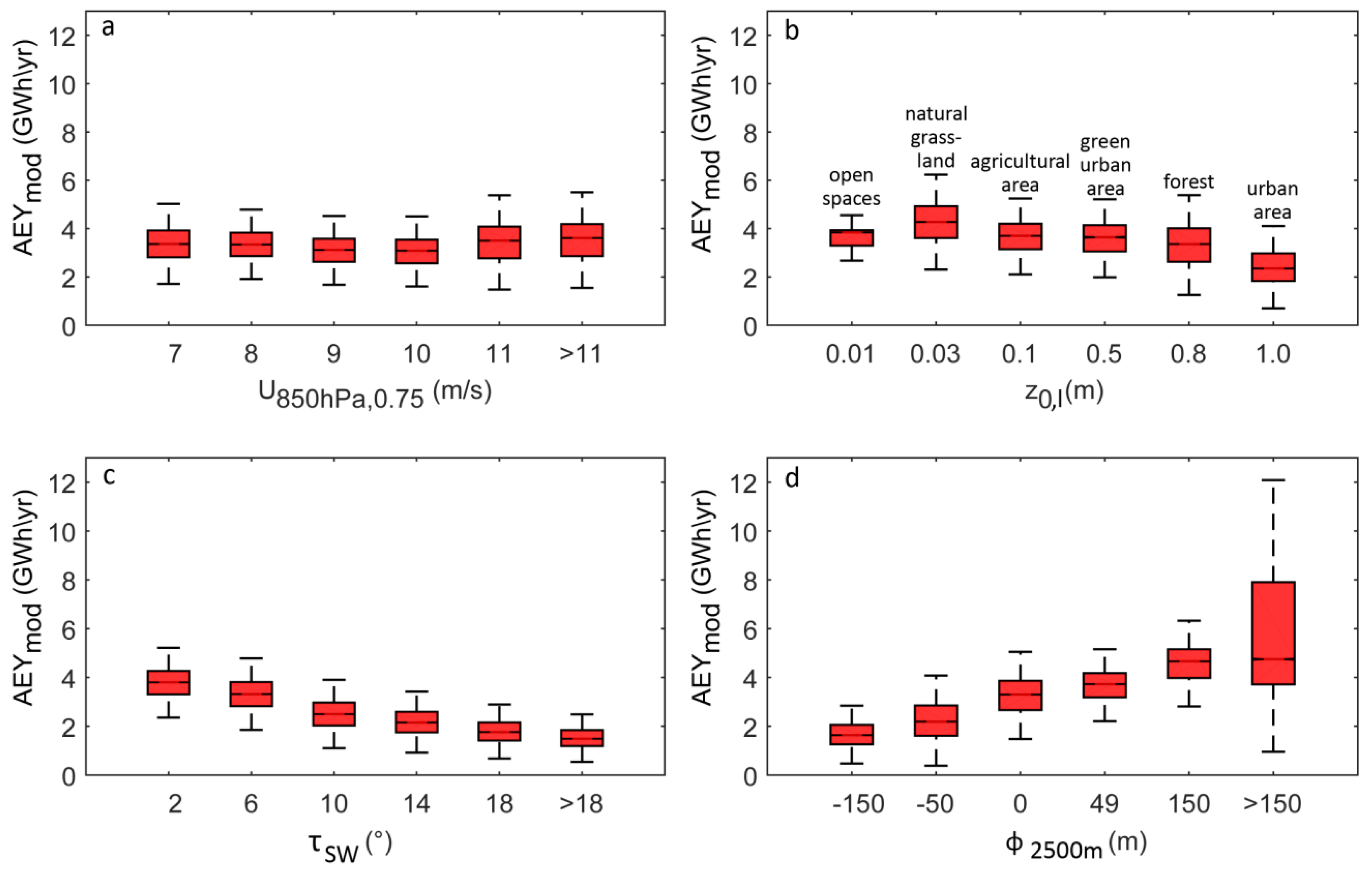2.1. Study Area and Wind Speed Measurements
The study area is the German federal state of Baden-Wuerttemberg (
Figure 1). The low mountain ranges Black Forest (length ~150 km, width ~30–50 km, highest elevations >1400 m) and Swabian Alb (length ~180 km, width ~35 km, highest elevations >1000 m) are the most complex topographical features with the strongest impact on the wind resource over the study area [
20]. The top of the Feldberg (1493 m) is the highest elevation in the study area. Approximately 38% (13,700 km
2) of the study area is covered with forests [
21]. More details about land cover and topographical features in the study area are summarized in [
20].
The wind speed database used in this study consists of time series of the daily mean wind speed measured from 1 January 1979 to 31 December 2010 at 58 meteorological stations by the German Weather Service (DWD). The height (
hS) of wind speed measurements varies between 3 m AGL (stations Bad Wildbad-Sommerberg, Isny) and 48 m AGL (station Karlsruhe). Data preparation included gap filling, testing for homogeneity and detrending according to [
20].
The median wind speed near the surface values (
) vary in the range 0.5 m/s (station Triberg) to 7.5 m/s (station Feldberg) (
Table 1). To extend the database, four measurement stations located in the bordering federal states Hesse and Bavaria were included in this study. Out of the 58 wind speed time series, 48 time series were put into a parameterization dataset (DS1). The remaining 10 time series, for which the original length was less than 10 years, belong to the validation dataset (DS2).
2.2. Wind Speed Extrapolation
All wind speed near the surface (
US) time series were extrapolated to 100 m AGL using the Hellman power law [
22,
23,
24]. It was demonstrated by [
11] that the power law performs well compared to similar wind speed extrapolation methods. According to [
22], the accuracy of the power law increases when stratification effects and the influence of the wind speed are considered. Therefore, the Hellmann exponent (
E) was computed on a daily basis.
As has previously been done by [
20,
25], daily mean wind speed at the 850 hPa pressure level (
U850hPa) and the height of the 850 hPa pressure level AGL (
h850hPa), both available from the European Centre for Medium-Range Weather Forecast [
26], were used to calculate daily, station-specific
E-values:
After the
E-values were determined, daily, station-specific
US-values were extrapolated to 100 m AGL yielding
U100m,emp:
2.3. Probability Distribution Fitting
Prior to the probability distribution fitting,
U100m,emp time series were transformed to empirical cumulative distribution functions (CDF
emp). Afterwards, 67 CDF were fitted to each CDF
emp. The goodness of fit (GoF) of each CDF was quantified by calculating the coefficient of determination (
R2) from probability plots [
19,
27] and the Kolmogorov-Smirnov statistic (
D) [
28,
29,
30] to the fits. The
D-values were obtained by measuring the largest vertical difference between CDF and CDF
emp. The transformation of time series, fitting and GoF evaluation were done by EasyFit software (Version 5.5, MathWave Technologies, Dnepropetrovsk, Ukraine) and Matlab
® Software Optimization Toolbox (Release 2015a; The Math Works Inc., Natick, MA, USA).
According to
D- and
R2-value evaluation, which will be presented in detail in the results section, the five-parameter Wakeby distribution (WK5) [
31] is clearly the best-fitting distribution. It can be defined by its quantile function [
20,
25,
31,
32]:
where
F is the cumulative probability with
U100m,distr (
F) being the associated wind speed value. The four parameters α, β, γ, and δ are distribution parameters and the fifth parameter, ε, is the location parameter. WK5 can be interpreted as a mixed distribution [
33] consisting of a left and right part [
31,
32]. This enables WK5 to reproduce shapes of wind speed distributions that other distributions cannot reproduce [
25,
31].
2.4. Predictor Variable Building
A total number of 92 predictor variables (50 m × 50 m) covering the study area were built by using the ArcGIS
® 10.2 software (Esri, Redlands, CA, USA). All predictor variables originate from a digital terrain model (DTM), CORINE Land Cover (CLC) data [
34] or ERA-Interim reanalysis
U850hPa [
26].
The DTM was used to map Φ, τ [
35,
36], curvature, aspect and slope. The Φ-values were calculated by subtracting the mean elevation of an outer circle around each grid point from the grid point-specific elevation. Five different Φ variants with outer-circle radii of 250 m, 500 m, 1000 m (Φ
1000m), 2500 m (Φ
2500m) and 5000 m (Φ
5000m) were created.
The τ-maps were built for eight main compass directions (northeast (22.5°–67.4°), east (67.5°–112.4°), southeast (112.5°–157.4°), south (157.5°–202.4°), southwest (202.5°–247.4°), west (247.5°–292.4°), northwest (292.5°–337.4°), north(337.5°–22.4°)) at 200 m radius intervals. This was done by summing angles up to a distance limited to 1000 m. Curvature, aspect and slope were calculated by using the Spatial Analyst Toolbox in ArcGIS.
Roughness length (
z0) was derived from CLC data with an original spatial resolution of 100 m × 100 m. Roughness length values were assigned to land cover types according to [
20] yielding the local roughness length (
z0,l). Additionally, “effective” roughness length values (
z0,eff) for the eight main compass directions were calculated. This was done for four different radii around each grid point (100 m, 200 m, 300 m, 400 m). In the end, all
z0-values were interpolated to 50 m × 50 m resolution grids.
U850hPa data (0.125° × 0.125° resolution) were included into model building because it represents large-scale airflow undisturbed by the surface [
37]. The 0.01, 0.30, 0.50, 0.75 and 0.99 percentiles of
U850hPa time series covering the period from 01 January 1979 to 31 December 2010 were calculated (
U850hPa,0.01,
U850hPa,0.30,
U850hPa,0.50,
U850hPa,0.75 and
U850hPa,0.99) and mapped in ArcGIS®. A spline interpolation was applied to convert the
U850hPa layers to 50 m × 50 m resolution grids.
2.5. Wakeby Parameter Estimation and Modeling
The procedure applied to obtain the Wakeby parameters at every grid point in the study area comprised the following work steps: (1) estimating the Wakeby parameters of every CDF
emp based on L-moments [
38,
39]; (2) analyzing the obtained Wakeby parameters and identifying common characteristics of all distributions ; and (3) modeling target variables (
Y) that enable the calculation of all WK5 parameters at every grid point in the study area. To make the WK5 parameter modeling more robust, the WK5 parameters estimated by L-moments were modeled indirectly according to [
20,
25].
Analyzing the estimated distributions led to the following parameter modeling and calculation approach: First, the estimated left-hand tail of WK5 (
YL), which is represented by α, β and ε, was modeled:
The estimated location parameter ε, which represents the lower bound of the distribution, was directly modeled. Because the L-moment-based WK5 parameter estimation showed that α = 10 at nearly all stations, it was set to this value. The use of a fixed α-value enabled the subsequent calculation of β.
Since
YL affected WK5 parameter estimation up to
F = 0.25, exactly as described by [
31,
32], the percentiles
F = 0.30 (
YR1),
F = 0.50 (
YR2),
F = 0.75 (
YR3) and
F = 0.99 (
YR4) were modeled to build the right-hand tail of WK5 (
YR). A system of non-linear equations was solved at every grid point yielding γ and δ:
In order to calculate U100m,mod, YL and YR were recombined yielding WK5 with modeled parameters (WK5mod).
All
Y were computed for every grid point by least squares boosting (LSBoost) [
40]. This was done by using the Ensemble Learning algorithm LSBoost implemented in the Matlab® Software Statistics Toolbox (Release 2015a; The Math Works Inc.). LSBoost is basically a sequence of simple regression trees, which are called weak learners (
B). The objective of LSBoost is to minimize the mean squared error (
MSE) between
Y and the aggregated prediction of the weak learners (
Ypred). In the beginning, the median of the target variables (
) is calculated. Afterwards, multiple regression trees
B1, …,
Bm are combined in a weighted manner [
41] to improve model accuracy. The individual regression trees are a function of selected predictor variables (
X):
with
pm being the weight for model
m,
M is the total number of weak learners, and
v with 0 <
v ≤ 1 is the learning rate [
20,
41].
The predictor variable selection process comprised several steps. First, the most appropriate length of outer-circle radii for τ and
z0,eff were determined by the correlation coefficient (
r) between τ respectively
z0,eff and
Y. Secondly, the importance of the remaining predictor variables was evaluated by predictor importance (
PI) which quantifies the relative contribution of individual predictor variables to the model output [
21]. The
PI-values were determined by summing up changes in
MSE due to splits on every predictor and dividing the sum by the number of branch nodes. All predictor variables with
PI = 0.00 were sorted out.
After
PI-evaluation, combinations of predictor variables were tested for their predictive power. Starting with one predictor variable, further predictor variables were added to the model and kept when the model accuracy measures
R2, mean error (
ME), mean absolute error (
MAE),
MSE and mean absolute percentage error (
MAPE) improved [
42,
43,
44]. For model parameterization, DS1 data were used. Model validation was done with both DS1 and DS2 data.
Multicollinearity among the predictor variables was investigated by assessing the variance inflation and the condition index in combination with variance decomposition proportions according to [
45].
2.6. Annual Wind Energy Yield Estimation
The relationship between wind speed and the electrical power output (
P) of wind turbines is typically established by a power curve [
46]. Power curve values are developed from field measurements and can be used for studies involving energy calculations [
47]. There are three important points characterizing a typical power curve (
Figure 2): (1) at the cut-in speed the wind turbine starts to generate usable power; (2) after exceeding the rated output speed the maximum output power (rated power) is generated; and (3) after exceeding the cut-out speed turbines cease power generation and shut down [
46]. A standard 2.5 MW power curve [
48] for onshore wind power plants was applied to calculate the
AEY.
The discrete
P-values from the manufacturer power curve were interpolated by a spline to obtain a continuous power curve. The basic attributes of the applied power curve are: cut-in speed
U100m = 3.0 m/s; cut-out speed
U100m = 25.0 m/s; rated output speed
U100m = 13.0 m/s and; rated output power
P = 2580 kW. The empirical annual wind energy yield (
AEYemp) was calculated for each station in DS1 and DS2 following [
49]:
with
N = 11,688 being the total number of days in the investigation period and the number of years in the investigation period (
Z1).
The average electrical power output (
) was calculated according to [
19,
50]:
The above equation describes the electrical power produced at each wind speed class multiplied by the probability of the specified wind speed class and integrated over all possible wind speed classes [
50] with
f(U100m,mod) being the probability density of
U100m,mod. After
is calculated modeled annual wind energy yield (
AEYmod) can be computed by multiplying
with the respective number of days per year (
Z2):
